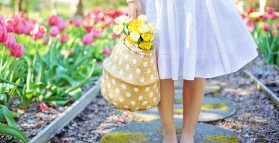Potting & Planting this Spring
Posted on Tuesday 18th September 2018

Potting & Planting this Spring
Spring is now here, which means it’s time to get out into your garden and watch it grow! Here are some activities and new ideas that will keep your plants performing their best.
Potting Mixes
You should repot your plants at least once a year and Spring is the best time to do it! A huge oversight many gardeners make when repotting is using poor quality potting mixes. They spend big money on beautiful plants only to pot them into cheap potting mixes, many of which lack the nutrients and physical structure needed to help your plants thrive. Potting mixes are made predominately of organic matter which breaks down in your pots, this lessens the pore space in the mix giving your plants less ‘breathing room’. Without this breathing room the roots of the plant cannot move, and water struggles to get through. Repotting with a fresh, high quality mix opens up this pore space again giving your plants the best chance to keep flourishing.
When choosing your potting mix remember to look for the Australian Standards 3743 logo (5 ticks) as this means the mix has undergone strict quality testing, ensuring consistency and good nutrient levels. It is also good to check the pack date, so you can get the freshest mix possible.
Planting Mixes and Raised Garden Beds
Raised garden beds are becoming very popular and for good reason! My Grandfather used to say that the older he became the further the ground moved away from him. Many of us experience the same thing when working in the garden. A raised garden bed can help fix this problem. They are easy to make and can be quite affordable. Popular building materials include wooden sleepers, old tanks, bales, bricks, blocks and pre-made iron. Whichever material you use, the secret to a successful raised garden is the soil. Together with the appropriate watering and a good position, your plants will thrive in their new home.
Soils need a good physical structure to have adequate pore space for water to flow and roots to move freely. Nutrient availability is at its highest and your garden bed performs its best in a pH range of about 6-7 which is ideal for most vegetables, herbs and fruit trees. The soil needs to have high levels of nutrients available to the plant which will allow for intensive growth. Add ingredients like pasteurised manures, composted food and green waste as organic nutrients; and crushed sandstone, fine grade basalt & blue metal, pelagonite, zeolite, spent coal ash and rock mineral products (or rock dust) as mineral components and water savers. There are some excellent planting mixes available with many of these ingredients already added to boost your raised garden bed success straight out of the bag. Again, when choosing a planting mix look for the Australian Standards logo, in particular AS4454 and AS4419.
The position of your garden bed is important as well, ensure that it is in close proximity to a water source and somewhere that will get the morning sun (this is a general rule - sun needs vary with types of crops grown and will change as things heat up into summer). Make it easy in the mornings to grab a hose or a watering can and give your bed a quick water. A basic irrigation system is the ultimate way to save you time and reduce the amount of water used and mulching is an excellent practice to conserve water. Choose a chopped feeder mulch like Sugar Cane or Lucerne as they are easy to spread, are very water retentive and continue to feed the soil as they break down.
So this spring enquire with the experts at Farmcraft about the best potting mixes available and setting up a raised garden bed, they have the supplies and know-how to get your garden growing in the right direction.

